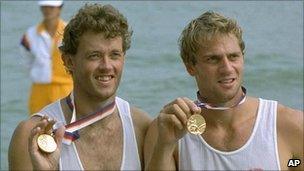What threat is Weil's disease?
- Published

Andy Holmes (left) and Steven Redgrave (right) won gold medals at the Seoul Summer Olympics in 1988
Rowers are still reeling from the news of the death of Great Britain's double Olympic champion rower Andy Holmes MBE.
Doctors suspect the 51-year-old athlete succumbed to an unusual, but severe form of an infection called Weil's disease or leptospirosis.
It's likely that Holmes, who had been involved in coaching over the past two years after returning to the sport, caught the disease from contact with dirty river water.
How worried should we all be about this disease?
Leptospirosis is found all over the world, including in the UK, but generally is more of a problem in hot places, like the tropics.
Animals, like rats and cattle, carry the bacterium and it can spread it to humans who come into close contact.
In the UK it is people like farmers, who work with animals, who are at greatest risk of infection.
But watersport fanatics, like canoeists and divers, who come into contact with lakes and rivers should also beware.
This is because the infection can be carried in water contaminated with animal urine.
The bacterium responsible can enter the body via cuts and abrasions of the skin, or through the thin lining of the throat, nose, mouth or eyes.
In recent years, the number of cases of infections have numbered in the 60s and 70s in England and Wales, according to the Health Protection Agency.
Each year the disease kills two to three people, says the HPA, which has been gathering data on infections since 1996.
And it is still a threat even if you are a fit rower who is in great shape for a middle-aged man.
Chris Williams, club chairman of the Tideway Scullers School in London, said the rowing community was shocked by Andy Holmes' death.
"It's very sad about Andy. We used to pass each other on the water from time to time.
"The disease is something all rowers know about. It's in all of our literature and safety programmes that stress good hygiene, like keeping cuts covered.
"But I don't ever remember hearing about another case like this.
"Everyone in the rowing world is enormously sad. He was a regular coach on the tidal part of the Thames where he trained club athletes. He was an icon who put time back into the sport and was heavily involved in rowing. It is a shame he can no longer do so."
He said it was unusual to catch Weil's from a stretch of river like the Tideway because it is a moving body of water.
"It tends to be stagnant water that is more unsafe."
Steve Redgrave told BBC Radio 5 live: "it is very rare that anything happens because normally rivers flow fast enough and dilute it."
Tony Reynolds, regional safety advisor for the Thames Region Rowing Council, said it was difficult to know where Andy might have caught the infection from.
"We just don't know and that is the worst thing. It can take weeks after catching the infection to develop the symptoms, which makes it harder to trace."
Symptoms can range from none at all to a mild flu-like illness, or a more severe illness called Weil's disease, with jaundice and kidney failure.
In most cases, with antibiotic treatment, the person will make a complete recovery. But for a few, it can be fatal even with the best hospital care.
Mr Reynolds said: "It's important not to speculate. But it shows that anyone can be at risk and how important it is to protect yourself.
"The disease is out there. Thankfully, there is enough information out there too to reduce your chance of being infected."
British Rowing says simple precautions, like covering cuts, scratches or sores with a waterproof plaster and showering after going out on the river, can minimise risk.